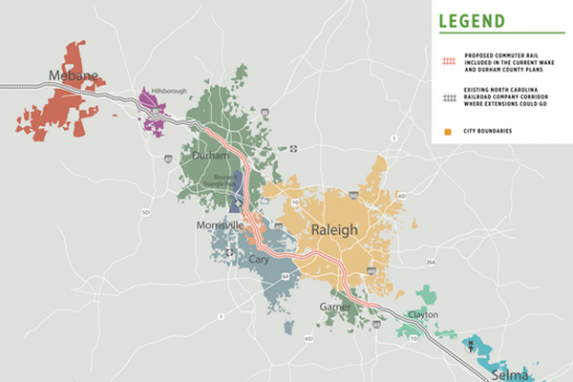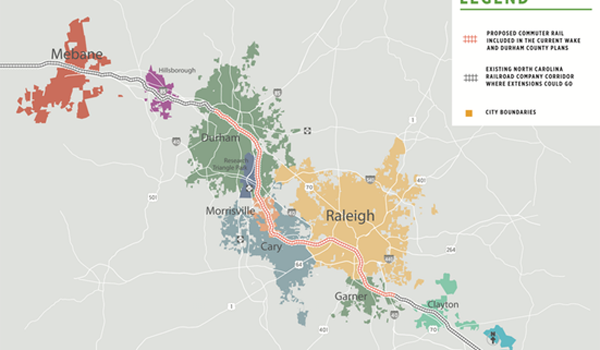By Mass Transit Magazine (Jan. 31, 2020)
Early studies of the commuter rail project included in Wake and Durham Counties’ transit plans have shown two out of the eight route scenarios studied would likely qualify for the federal funding needed to complete the project.
An exploratory study, known as the Major Investment Study (MIS), was authorized by the two counties and completed in May 2019. The study looked at the people, homes and businesses along the corridor and evaluated environmental factors that could affect the project.
Among the preliminary findings of the MIS were:
- Taking a train between Durham and Garner would be faster and more reliable than driving or taking a bus.
- Commuter rail ridership in the Triangle would be consistent with that of similar systems across the country.
- Providing service every 30 minutes in peak periods and limited service midday and evenings would be the most productive scenario in terms of ridership of the ones studied.
A later study, called the Greater Triangle Commuter Rail Study, further analyzed the viability of commuter rail in the corridor by also looking at the infrastructure, such as additional train tracks, needed to support the project and developing more detailed but very preliminary ridership projections and cost estimates. This information was needed to assess the project’s potential eligibility for federal funding as well as to determine whether additional phases of study should be completed before deciding whether to design and build a commuter rail project.
At the request of neighboring counties and the North Carolina Railroad Company, that study, completed in January, also analyzed the feasibility of adding Johnston County/Selma and Orange County/Mebane to the commuter rail line originally proposed to run 37 miles along the North Carolina Railroad Corridor between Garner and West Durham. The original plans call for stops at downtown Raleigh, N.C. State, Cary, Morrisville and Research Triangle Park (RTP) along the way.
As the Triangle continues to grow by more than 80 people a day, voters in Wake, Durham and Orange counties all have passed half-cent sales taxes to invest in transit improvements. The proposed Durham-Wake commuter rail project is just one part of a community effort to create a unified transit network that makes it easier for residents to access jobs, education and health care across the region. The counties also are adding more buses that go more places more often, more bus stops and transfer facilities and bus rapid transit projects, among other improvements.
“Today, if you try to commute between Garner and RTPor maybe between Durham and Cary, it might take you less than 30 minutes and other times can be more than 50 minutes of aggravation, and it’s only going to get worse,” says Sig Hutchinson, member of the Wake County Board of Commissioners. “Commuter rail would offer our residents a chance to relax or work in comfort while they get to key destinations in the same amount of time every time.”
 The next steps: more study, public engagement, risk assessment
The next steps: more study, public engagement, risk assessment
The next step is for county officials to decide whether the preliminary results warrant further study and whether to amend transit plan budgets to add up to $9 million for the next phase.
The next phase would include:
- Proactive and comprehensive community engagement to share information and get feedback from the public needed to update transit plans in all three counties.
- Evaluation of needed railroad infrastructure improvements and construction.
- Further evaluation of potential risks to the project and their potential solutions.
During this additional phase of study, project management partners, including the counties, also would develop and sign initial agreements with one another, the railroads, municipalities, metropolitan planning organizations and other key stakeholders to assign roles and responsibilities during the project’s design phase.
These agreements would focus on cost-sharing; on concept details such as how many tracks are needed, where stations might go and where park-and-rides and a maintenance facility might be located; and on working out details with authorities that have jurisdiction over portions of the project on how the parties intend to work with each other going forward.
Information about the two studies is being presented to governmental bodies in public board meetings throughout February to give the public an opportunity to ask questions about these preliminary results, an informational open house has been scheduled Feb. 22.
“Before a major capital project like this can proceed, we need to assess whether the potential benefits are worth the larger investment,” says Wendy Jacobs, chairwoman of the Durham County Board of Commissioners. “We now have preliminary findings that show commuter rail would be faster than driving while also expanding residents’ transportation access to jobs and that we have scenarios that could qualify for federal funds. We want to make sure residents are informed about where we are in this process with this potential investment and proposed next steps.”
The two routes likely to qualify for federal funds
The Federal Transit Administration evaluates a transit project on local financial commitment, mobility improvements, environmental benefits, congestion relief, cost effectiveness, potential for economic development and existing land use and an overall rating of medium is needed to receive a federal grant, which could fund up to 50 percent of the project.
Initially, six commuter rail scenarios were studied, and preliminary results in December showed that a route running 40 times a day (20 round trips) between Garner and West Durham would be most likely to qualify for federal funding. Additional study results received Jan. 8, 2020, show that a route between Durham and Clayton in Johnston County with 40 weekday trips (20 round trips) also likely would meet the federal criteria. Johnston County would decide whether to create a designated transit funding source to help pay for extending the project from Garner in Wake County into Clayton.
A look at preliminary numbers
The Garner-Durham route and the Clayton-Durham route with eight trips in each direction during peak hours and two each during the midday and evening were the only scenarios that appear likely to score a medium. The Garner-Durham scenario, which could eventually carry an estimated 7,500 to 10,000 passengers a day, would cost approximately $1.4 billion to $1.8 billion to build and $29 million a year to operate and maintain. The Clayton-Durham route would cost $1.7 billion to $2.1 billion to build and $37 million a year to operate and maintain and is projected to carry a similar range of passengers.
By comparison, stretching the route from Mebane to Selma with the same number of trips would cost approximately $2.5 billion to $3.2 billion to build and $57 million a year to operate and maintain while eventually carrying an estimated 8,000 to 11,500 daily passengers.
GoTriangle says it is important to note that all estimates from the initial studies are preliminary and likely would change after additional study and any early engineering work.
The studies also have indicated that any viable commuter rail project running in the existing North Carolina Railroad corridor would require the construction of at least 34 miles of new parallel track depending on the number of new daily trains. Future analyses, in coordination with the North Carolina Railroad Company and the operating railroads in the corridor, would further refine capital requirements for adding tracks, bridges and other infrastructure.
A team of project management partners including representatives from North Carolina Railroad Company, NCDOT, the Research Triangle Foundation, four counties and two metropolitan planning organizations in the corridor has been meeting regularly to review and discuss study findings and opportunities for the commuter rail project.
Presuming the commuter rail project advances, the public will be heavily involved in reviewing findings and providing feedback to help shape the future of commuter rail in the region.






